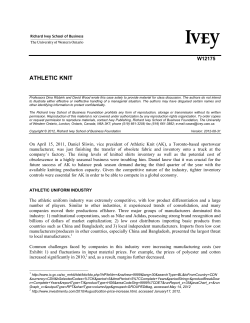
BUSINESS A18
A18 THE HAMILTON SPECTATOR THURSDAY, JUNE 30, 2011 thespec.com BUSINESS Business desk at 905-526-3420 Big plans loom at old knitting mill Unique partnership promises new life for derelict building BY MEREDITH MACLEOD A vacant former knitting mill in Hamilton’s poorest neighbourhood is the first purchase of a unique partnership between the city and a private equity company. Hamilton Realty Capital Corporation bought the Cannon Knitting Mills at Mary and Cannon streets in the Beasley neighbourhood for an undisclosed price in January. Environmental assessments and rezoning applications are under way as the developer and a team led by local architect David Premi determine the best and most feasible uses for the property. Those possibilities include residential, retail, office space, artists’ studios, museum space, a postsecondary campus or maybe a mix of all of that. The 110,000-square-foot building is a complex of about five structures built between 1854 and 1950. It had been up for sale for $800,000 for a number of years, and while several investors from Toronto came to take a look, for various reasons — the scale and condition of the building, potential environmental problems, the nearby Good Shepherd building, the traffic hurtling by on Cannon — they all shied away. The owners of the mill, L & S Realty, hinted that taxes, insurance and utilities might leave them no choice but demolition, says Glen Norton, acting manager of the city’s downtown renewal division and manager of HRCC. “We urged them not to do that and quite rightly they said, ‘Put your money where your mouth is.’” HRCC, which is backed by Forum Equity Partners, a Toronto-based private real estate developer, wanted to keep the purchase quiet until they had a plan worked out for the building’s future, but the deal hit Hamilton news blog Raise the Hammer this week. “We want this to be a catalyst … but we have to find the right solution,” said Norton. “We are starting to look at … what makes sense for the community, what can we afford to do.” Paul Sousa, chair of the Beasley Neighbourhood Association, says the knitting mill is critical to the area and there were fears that the building could be lost, perhaps to neglect or to fire, but “I was confident somebody would recognize the jewel that it is.” Now he dreams of a restaurant with a patio looking over the adjacent Beasley park, shops and mixed rent housing. The massive, three-storey structure is dotted with broken windows and littered with pigeon droppings inside. water damage has caused the wood floors to buckle and paint flakes to fall from the wooden ceiling. But the space inside is enormous, well lit and wide open — perfect for urban condos or office space — broken only by thick Douglas fir posts. The imprints of knitting looms are still visible in the worn floors upstairs. There are numerous wood freight elevators and those rolling steel fire doors so prized in retrofitted buildings. Everywhere he looks, Norton sees opportunity. A boiler room surrounded by thick brick walls and concrete floors is the perfect spot for a microbrewery featuring a tasting room and sandwich bar. The most impressive part is a long atrium-type space down the centre of the structure. It was once PHOTOS BY LORNE CHESAL, SPECIAL TO THE HAMILTON SPECTATOR Hamilton photographer and Beasley resident Lorne Chesal plans to document the transformation of the Cannon Knitting Mills. His photos can be seen at passionateaboutpictures.com/seepix/galleries/ckm/. the area where fabric was dyed. It’s almost churchlike with wood beams criss-crossing the soaring ceiling and windows circling the roofline. Whatever the end use is, it has to be viable, says Norton. The city lent HRCC $2 million from the Future Fund to get started and Forum is not in the game to lose money. HRCC, which aims to leverage $40 million of investment downtown, is entirely owned by Forum president Richard Abboud. Yet while the city has no stake in the company, it gets 50 per cent of the vote on projects to tackle. Abboud is reluctant to offer timelines or the level of investment the project will entail. He’s never ventured into a restoration before, usually partnering with municipalities and governments to build court houses, detention centres, arts venues, mixed use housing, schools and public buildings. Forum’s most recent project is a $225 million town centre in Or- leans, Ont., featuring an arts and cultural centre, a hotel, office buildings, retail and commercial space, a seniors’ home, housing and green space. Abboud says his company is “bullish on Hamilton”, especially if light-rail transit and all-day GO trains materialize. Little is known about the history of the mills, says architect Premi. There is legend that the oldest part of the building was once a hotel. Over the years, Cannon Knitting made hosiery, school curtains, bedding for hotels and milled cotton into bolts. “This was the economic engine at one time of this neighbourhood,” he said. “It was a provider for Beasley and beyond. The whole idea of transforming it back to something that can act as an economic engine and restore its purpose is exciting and meaningful.” Premi says the community will have plenty of say in what happens with the building. At a recent design workshop, neighbours Business group slams political ‘disconnect’ BY STEVE ARNOLD Hamilton’s business leaders say a lack of political support is hobbling efforts to revive the city’s economy. In a meeting with The Spectator’s editorial board Wednesday, members of the business lobby complained they’re not getting the support they need from city council on crucial issues such as the light rail transit proposal, all-day GO service and efforts to attract new employers. “We just don’t appear to have any champions,” said Doug Duke, executive officer of the HamiltonHalton Home Builders’ Association. “We have to act like a city that deserves these things and right now we don’t have the political will to go and get them.” Hamilton Business Leaders brings together the heads of the Chamber of Commerce, home builders, realtors’ association and airport to push a jobs and prosperity agenda for the city. They argue city councillors should use that lens in looking at every decision they make. “There appears to be a real disconnect between the business leadership and council right now,” said Ross Godsoe, CEO of the Realtors Association of Hamilton-Burlington. “We just don’t see these issues being championed by city leadership. “It’s a tough job for us to even get a meeting with the mayor now,” he added. The last time the business group met with Mayor Bob Bratina was in November, just after the municipal election. They’re not scheduled to get together again until July 21. Bratina “flatly rejected” the group’s contentions. The most recent example of that disconnect, the business group said, is a decision this week to increase industrial development charges by almost 60 per cent over 18 months. The proposal to hike the fees to $10.58 per square foot, higher than the $8.85 recommended by city staff, means the levies in Hamilton will be among the highest outside the Greater To- DOLLAR 103.03 US +1.27 EURO 1.401 Cdn –1.09 ronto Area, a fact the business group fears will drive new jobs away from Hamilton. The plan was approved by the city’s general issues committee Monday but city council voted against the proposal Wednesday night, opting for the phased-in schedule. “Obviously this proposal … is a huge challenge for us and sends a very bad message out,” Duke said. “I just don’t know why you would dismiss the staff numbers and introduce a new number that puts us at the top of the grid. “You have to ask at what point do we price ourselves out of the market?” he added. “This could really affect a decision to locate in Hamilton.” The business leaders added they feel the same lack of support from council and the city’s MPPs over the drive to get all-day GO service and a LRT system built here. “Our political leaders have to play politics in Toronto for Hamilton,” Duke said. “So far we haven’t received any feedback to say this is even a priority.” The business leaders group pushed their agenda through the municipal election last year, this year’s federal election and will argue their case again during the provincial election set for October. TSX 13,188.94 +83.95 TSX VE 1,892.36 +26.68 thought it should include retail, a coffee shop, perhaps a community kitchen or arts school. Neighbour Bob Ralph, who owns an immaculate two-storey stone house across the street, just a year or two younger than the knitting mill, is thrilled to learn there are plans to revive the building. “This city is a jewel. People don’t see that, but I see how the city is moving forward,” said Ralph. mmacleod@thespec.com 905-526-3408 Inflation spike adds pressure for rate hike BY JULIAN BELTRAME HAMILTON SPECTATOR FILE PHOTO Hamilton Mayor Bob Bratina rejected the business group’s assertions. “Our goal is to hold everyone’s feet to the fire and try to move this city ahead,” Godsoe said. “Our agenda is still centred around the opportunity for jobs and prosperity.” In an interview, Bratina said the city’s current unemployment rate of 5.4 per cent shows the economy is performing well and that shows the city is on the right track. On the thorny transit issues, he said he’s fully supportive of expanded GO service, but has reservations about the LRT plan. He also doesn’t think there’s wide public support for the plan. “We still haven’t figured out what all the costs of that are going to be,” he said. “We’re not hearing any kind of clamour from the public on that file.” The mayor also defended the development charge issue, noting Hamilton’s charges “aren’t out of line” with the levies in neighbouring municipalities and even with the increase the city is still attractive to investors because of reasonable land costs and ready access to a pool of workers. “It’s hypocritical of them to talk about Code Red and helping people while raising taxes to pay subsidies to corporations that want to locate here,” he said. sarnold@thespec.com 905-526-3496 Higher development fees are coming, just not so soon City council has backed off plans to dramatically hike industrial development fees, opting for the phased-in schedule of increases previously suggested by staff. New industrial development charges of $8.85 per square foot will take effect in 2013, up from current fees of $6.65 per square foot. Staff will report back on the impact of the change — and prospects for another increase — before 2013. That’s a step back from an ambitious, surprise motion proposed by Councillor Brian McHattie Monday that would have seen fees rise al- The exterior of the cotton mill has seen better days. most 60 per cent over 18 months to $10.58 per square foot. That proposal prompted business leaders to warn that council risked scaring away potential new manufacturing companies and jobs. “This is going to encourage people not to develop industrial land in Hamilton,” John Iannuzzi, a member of the Realtors Association of Hamilton-Burlington, said just before Wednesday’s meeting. Other councillors and city staff members echoed that fear. Tim McCabe, economic development and planning general manager, TSX 60 757.30 +4.08 DOW 12,261.42 +72.73 told councillors Wednesday he was “in shock” at the prospect of raising the fees to $10.58 so quickly. “That just isn’t going to work,” he said. “We believe in a philosophy of a phase-in.” McHattie, who pitched the higher fee hike, said he objects to ratepayers having to “eat” the $9-million shortfall in growth-related costs. Council voted 11-5 in favour of the phased-in fee increase amendment. A special meeting will be required Monday to pass the related bylaws. mvandongen@thespec.com 905-526-3241 S&P 500 1,307.41 +10.74 Nasdaq 2,740.49 +11.18 OTTAWA F Canada’s annual inflation rate jumped to the highest level in eight years last month, rising to 3.7 per cent as big increases in gasoline prices pushed the index to a new post-recession peak. On a month-to-month basis, consumer prices rose by a significant 0.7 per cent in May from where they were in April, Statistics Canada reported Wednesday. The magnitude of the increase was unexpected. Economists had predicted it would stay at 3.3 per cent for the third straight month. The surprisingly strong increase in prices paid by consumers present the Bank of Canada with a dilemma less than three weeks before its governor and his deputies meet to set short-term interest rates for the country. Market reaction following the Statistics Canada report suggested the chances of a rate hike — if not July 19, then possibly in early September — had increased. The Canadian dollar rose more than a penny against the U.S. greenback Wednesday and traded above $103 cents US for the first time in a week. But analysts were not convinced Bank of Canada governor Mark Carney will be spooked enough to risk further depressing a weak economy by raising the cost of borrowing. For one thing, Carney had warned as far back as April he expected inflation to push above 3 per cent during the spring. For another, most of the increase is attributed to one cause — petroleum-based energy prices. Statistics Canada noted that gasoline prices were 29.5 per cent higher in May than they were a year earlier. Gasoline in May was just below the record high reached in July 2008 just prior to the economic meltdown. Excluding gasoline, the annual inflation rate would be 2.4 per cent. The Canadian Press GOLD 1,510.40 US +10.20 US OIL (FUTURES) 94.77 US +1.88 US THE MARKETS I TSX boosted by stronger-than-expected inflation, Greece austerity bill passes I Full stock listings on Go 16 For the third consecutive day, the TSX closed higher. The Greek government passed its austerity bill, which paves the way for the country to get its next series of vital bailout C M Y loans. Traders breathed an initial sigh of relief and will now watch to see what happens next. However, the post-recession peak in the inflation rate could put pressure on the Bank of Canada to take a more hawkish tone in its next interest rate announcement. — The Canadian Press
© Copyright 2025





















